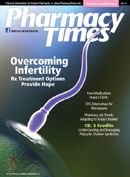Publication
Article
Pharmacy Times
OTC Case Studies: Women's Health


BL is a 20-year-old college student who presents to the pharmacy at her school’s student health center. She reports a 2-day history of pain on urination, vaginal itching, and a thick, white discharge. She denies having any allergies to medications or other medical conditions. She reports she is sexually active with 1 partner and uses latex condoms for birth control. She recalls having a yeast infection once before a few years ago, which she remembers taking a prescription to treat. To avoid another doctor’s office visit, she reports purchasing the Vagisil Screening Kit the night before and that the results indicated a vaginal pH of 4.0. Based on the results of the test and her current symptoms, identify what condition BL is likely suffering from. Consider which OTC product you would recommend and what counseling points you would want to reinforce to assure correct use.
Answer
Vaginal disorders are common ailments that send women into pharmacies seeking self-treatment. In this case, BL is likely suffering from vulvovaginal candidiasis (VVC), or a yeast infection. Her symptoms that are characteristic of VVC include vulvar itching, dysuria, and having an abnormal thick, white vaginal discharge. Vulvar edema, erythema, dyspareunia (painful intercourse), and an absence of a malodor are other symptoms that may occur with VVC. Although these symptoms are consistent with a diagnosis of VVC, it is important to realize that symptoms alone may mimic other vaginal conditions and are often nonspecific. In a young, sexually active woman, it is important to rule out symptoms of sexually transmitted infection, including trichomoniasis and bacterial vaginosis. These conditions are usually associated with different symptoms, including odor and discolored or frothy discharge, and tend to cause elevations in vaginal pH above 4.5. Our patient reports utilizing a home vaginal pH test and obtaining a reading that is consistent with a fungal infection, which typically does not cause elevations in vaginal pH. Considering she also reports having a medically-diagnosed yeast infection previously, the pharmacist can be confident in recommending selftreatment with an antifungal preparation.
OTC imidazole antifungal products, including butoconazole, clotrimazole, miconazole, or tioconazole, are appropriate for the self-treatment of VVC. Product selection should be based on patient preference and symptoms. Combination products are available for both internal and external application. Rates of cure are similar among all products, regardless of duration of therapy. It is important to counsel BL on appropriate application technique—ie, apply at bedtime to avoid product leakage and follow directions for filling applicators and inserting vaginal creams and suppositories—and also remind her that these products can affect the integrity of latex condoms.
CASE 2—Plan B
RB is a 19-year-old man who presents to the pharmacy requesting Plan B (levonorgestrel). He states that an “accident” occurred last night around 8 pm with his girlfriend, LM. Upon further questioning, he states they have been using the withdrawal method to prevent pregnancy. However, last night they had a few drinks and got caught up in the moment. He wants to purchase Plan B. He also states they have used Plan B once before about 15 months ago. What is important to counsel RB on before dispensing Plan B One-Step?
Answer
Plan B One-Step is now available without a prescription for women 17 years of age and older. Because intercourse occurred within 72 hours, it would be appropriate to use Plan B One-Step for the prevention of pregnancy. RB should be counseled to instruct LM to take the dose as soon as possible. Plan B One-Step now comes as 1 tablet instead of 2, so this may be new to LM since the last time she purchased Plan B. If vomiting occurs within 2 hours of taking the tablet, consideration should be given to repeating the dose or contacting her physician for further instruction. The most common adverse reactions are heavier menstrual bleeding, nausea, lower abdominal pain, fatigue, headache, dizziness, and breast tenderness. It is important to counsel RB that Plan B is not indicated for routine use as a contraceptive. RB and LM should be strongly advised to speak to a physician about alternative methods of preventing pregnancy.
Dr. Bridgeman is an internal medicine clinical pharmacist in Trenton, New Jersey, and clinical assistant professor, Ernest Mario School of Pharmacy, Rutgers University. Dr. Patel is a clinical pharmacist in North Brunswick, New Jersey, and clinical assistant professor at Ernest Mario School of Pharmacy, Rutgers University.







